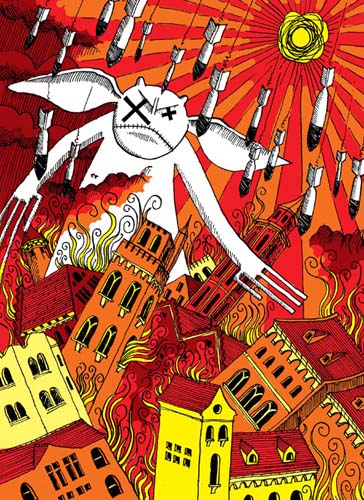Donwood’s comments about the image below, see message 232, politicize the blinded monster’s destruction, making it a stand-in for the U.S. military in Fallujah.

The monster’s whiteness and the white “incendiaries” recall accusations that during Operation Phantom Furyâ€â€an Operation later renamed Operation Al-Fajr, or “dawn” in Arabicâ€â€the U.S. military used white phosphorous bombs as incendiary devices. According to the U.S. Department of State, this accusation first surfaced in a 3 December 2004 opinion editorial by Sam Hamod in Al-Jazeerah which claimed the U.S. used “outlawed napalm, poison gas and phosphorous shells.” The same month, the U.S. Department of State, on its “Identifying Misinformation” web site, denied any U.S. use of napalm, continuing: “Phosphorous shells are not outlawed. U.S. forces have used them very sparingly in Fallujah, for illumination purposes. They were fired into the air to illuminate enemy positions at night, not at enemy fighters.” In November 2005 a documentary by Italian state television, Rai, revived claims that the U.S. military used white phosphorous bombs as incendiary devices on Fallujah. On 10 November, 2005, the U.S. Department of State updated its 9 December 2004 article with this bracketed note:
we have learned that some of the information we were provided in the above paragraph is incorrect. White phosphorous shells, which produce smoke, were used in Fallujah not for illumination but for screening purposes, i.e., obscuring troop movements and, according to an article, “The Fight for Fallujah,” in the March-April 2005 issue of Field Artillery magazine, “as a potent psychological weapon against the insurgents in trench lines and spider holes ….” The article states that U.S. forces used white phosphorous rounds to flush out enemy fighters so that they could then be killed with high explosive rounds.
To its credit, the U.S. Department of State has not deleted the earlier statement, but the ambiguous passive voice shifts blame, “we were provided,” and the relative clause claim that phosphorous shells “produce smoke,” is true, but obscures the fact that, as a U.S. Department of Health and Human services web site says: “White phosphorus munitions are intended to burn or firebomb the opponents, in other words, to effectively produce widespread damage but not kill the enemy.”

